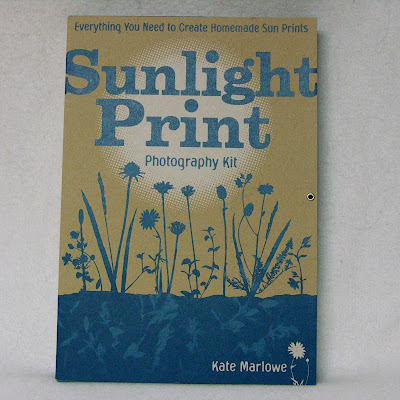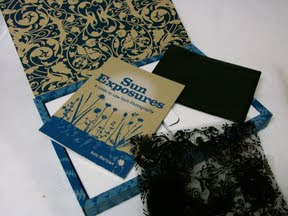
I was surprised when I walked into the local Barnes and Noble bookstore a few weeks ago and saw a cyanotype printing kit by the front door. Cyanotypes are one of the oldest alternative photographic processes that are easily done, and combined with modern digital techniques, remain an accessible way to make original art from photographs (more on that later). You might have seen the original "Sunprint" kits in catalogs or in gift shops. The kits were really nothing more than a dozen sheets of 4x4" blueprint paper, a rectangle of acrylic, and a sheet of instructions for making prints. I used larger sheets years ago when I did a workshop with 4-H kids.
So, I purchased this attractively packaged kit for $14.99 (it was less with my B&N discount card), and opened it up after I got home. It's a nice little introduction to cyanotypes, and what sets it apart from the "Sunprints" package is the included book by Kate Marlowe. Sun Exposures, A guide to Low-Tech Photography is a nice introduction to photograms, alternate processes, and low-tech cameras, such as pinholes. I was surprised by the small book, and it's obvious that this kit would make a nice gift for budding photographers and anyone that enjoys the hands-on of DIY photography.

The kit includes the book, sheets of cyanotype paper, and acetate overlays to create some different photograms. The back of the book has a list of resources and suppliers for those that want to do more with cyanotypes and other photographic techniques. I think it's $15 well-spent.
You don't need to just use some flat objects to make photograms to have fun with cyanotypes. You can shoot digital and use a graphics program to make a digital negative, which you print on overhead transparency film (denser negatives work better) and then use that to produce a positive cyanotype. Or, you can scan in a film negative and do the same. Or, you can find antique glass photographic plates and make prints from them on the cyanotype paper. Of course, larger negatives = better prints. Anything larger than a medium format negative (6x6 cm) will be suitable.
The other beauty of cyanotypes is that if you use blueprint paper, all you need is water to process them. No darkroom needed. Cyanotypes remain a viable artform, and you only need to go to the Alternative Photography website to view some nice work. The Detroit Institute of Arts has held cyanotype workshops in its new wing. One web resource has videos showing how to make your own cyanotypes.
So, all you really need now is some sun. I see it it's going to be a sunny day here (finally). Time to go make some prints!

2 comments:
I really enjoy doing cyanotypes, but I find that the pre-packaged kits give really weak tones and tend to fog. Cyanotype does seem to benefit from coating, drying, and printing within a couple of hours at most.
The good thing is that cyanotype chemistry is cheap (about $20 of chemicals will last a lifetime) and any good strong watercolour paper will work.
A handy tip is to add a bit of hydrogen peroxide (either "chlorine-free bleach" or first-aid peroxide, but not Oxi-Clean) to the final wash. This brings up the final colour without waiting for dry-down. Very dramatic.
I just bought this kit, and am excited to try it. I also bought a "create your own pinhole camera" kit, and am excited to try that!
I'm a native Michigander, but recently moved to Texas - and if you can believe this, we have more snow than y'all do up North.
Waiting on the sun, so I can make some vintage looking prints.
Love your blog, so glad I found it!
:)
Post a Comment